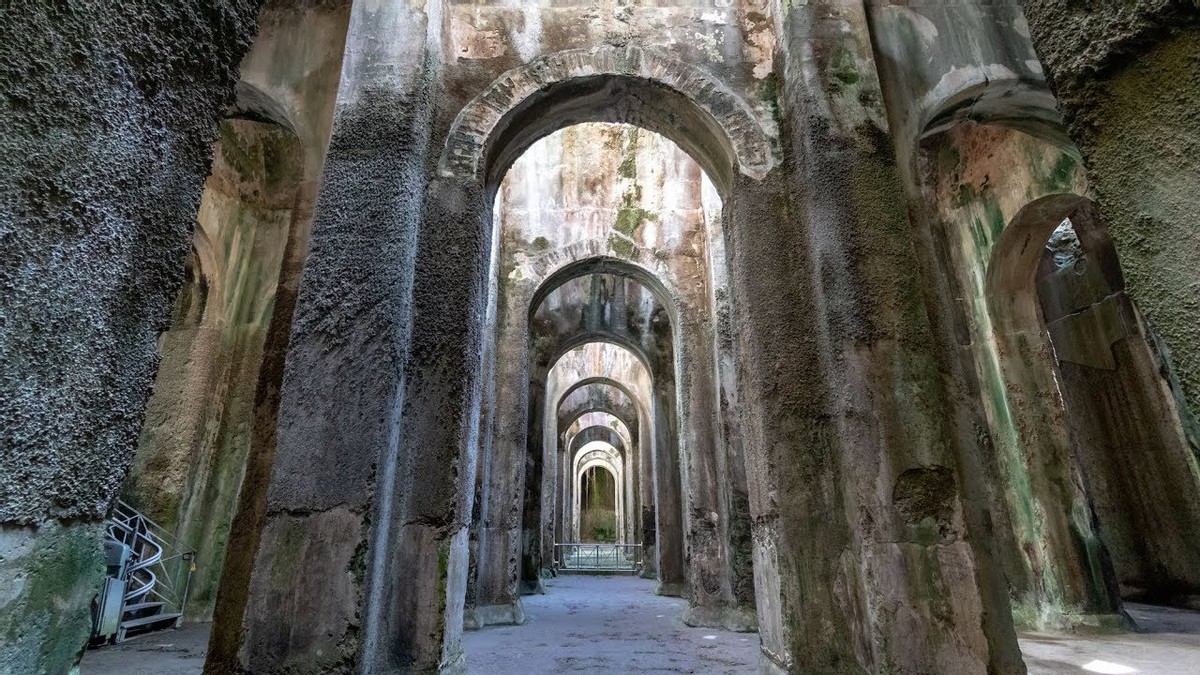
....continues from part 1
Bacoli is full of ancient Greek and Roman's testimonies, along with other subsequent landmarks left by the Aragon Kingdom's supremacy and by the Borbone Royal Family's dominion.
Lake Avernus, one of the four volcanic lakes in the area, was in Greek mythology the set of the battle between Zeus and the Titans. The great classic poet Virgilio described the lake as the Hell's Entrance due to its sinister landscape and to the absence of fish and birds; for the Romans it was the place where living people could meet dead people, the name itself was a synonym for the underworld. The Romans also converted the lake into a strategic internal naval base linked by a canal to a nearby lake (Fusaro) and, from there, to another naval base in the sea (near Cuma). In the Divine Comedy the lake was Lucifer's terrestrial dwelling.
In the archaeological site of Cuma you can see Ancient Greek and Roman ruins along with the Sibilla cave. Sibilla was a High Priestess devoted to Helios God. She was a sort of "qualified fortune teller" and used to practice her activity of forcasting events inspired by the Deity.
Bacoli, called Bauli by the Romans, and its hamlets (ancient Baiae, Cumae, Avernus, MIsenum) became a sort of VIP tourist and residential area, where the aristocratic Romans built their sumptuous mansions, which were used as holiday residences between a duty and another in Rome. Along with these magnificent villas they built entertainment sites, such as theaters and thermal baths. That's why here and there within the Bacoli Municipality Territory you can find remains of baths, villas, theaters, mausoleums, columbariums, bridges, canals, ports and aqueducts. (In the neighbouring Pozzuoli Municipality it is important to remember to visit the Flavio Theater, famous for being the gladiators' headquarters).
Due to the rise of the sea level, many of these ruins are now underwater and scuba diving expeditions are organized to visit the "Submerged City of Baiae".
In the center of Bacoli, about ten meters underground, there's a huge tank that gathered significant amounts of water for the Roman aqueduct. It's called "Piscina Mirabilis" (in the photo above) and it's a very fascinating site to visit. It looks like a cathedral, it will leave you in awe!
In addiction, the Bacoli hamlet of Misenum (a beautiful rock promontory with a long beach along side) was chosen by the Romans to become the base of the Roman fleet of the South Tyrrhenian Sea; you can see a monument called "Sacello Augustali", testimony of the importance of this seaport in the ancient history.
Looming over the Bacoli and Baia city centers, there is the Aragonese Castle, an enormous fortification that is a witness to the grandiosity of the Aragonese Influence. Today the castle's rooms host the Museum of the Phlegraean Fields (another name of Roman origin you can call this area referring to its underground caldera) which is worth a visit: you can see retrived ancient artefacts along with reproductions of temples and villas with private thermal baths. From over there (and from the top of other hills like Miseno, Scalandrone, Monte di Procida, etc.) you can see the coast with its cliffs and beaches and you can see the Island's outlines (Capri, Procida and Ischia Islands).
In the middle of the Lake Fusaro lies an elegant villa, ordered by King Ferdinando Borbone and planned by the famous architect Vanvitelli (the same who planned Caserta Palace). It's called "Casina Vanvitelliana" and was a house used for hunting, even though it seems the King also used to take his lovers there. In the 70's it was also used as set of the film "Pinocchio Adventures", so some people started to call it "Pinocchio's home". At some hours of the day it's open for visiting and it's often used as wedding location.
I think this area is unique for its myth, landscapes, thermal waters, and for a hundred more reasons.
And I think the Romans were not stupid to valorize this territory.
Actually, this place is still teeming with people and tourists. In the summer the traffic is so congested that at some hours of the day you can't go out on the streets. But they are mostly local people who come from Naples and suburbs.
So I'd like to speak with the people who come from other regions to Campania to visit Naples, Capri, Ischia, the Amalfi Coast, the Cilento Coast, Pompeii and Hercolaneum ruins, Mount Vesuvius, Caserta Palace and all the famous attractions nearby: Good choice!!...But I recommend that you spend a few more days and include a quick visit to the little town of Bacoli!!!
Elena, very interesting piece and well written. You know, my husband and I visited Naples and its surroundings two years ago in April, we fell in love with the region and its history. We did not visit Bacoli, but we did visit the Archaeological Park of Paestum with its Greek temples. I thought I was in heaven. I know for sure we will go back there again, there is so much to see for a history fan like myself, we will certainly include your suggestion. Thank you and keep going, you are doing great.
Wonderful Elena, thank you!